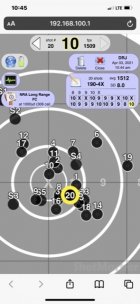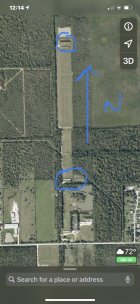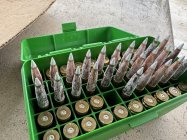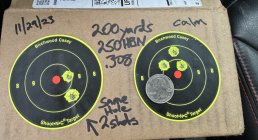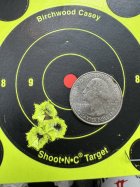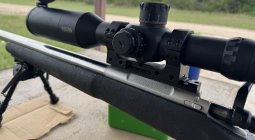I dropped an average of 10 points a match and this target pic is representative. The best SD of 8.0 was good relative to my rifles and other guns today, but some of my calls, and a few of the times I didn’t move, took a big toll.
This was due in even parts a mixture of both bad wind calls, and also my strong curiosity of just how it would compare to what I’m used to when “shooting it like I would an open” gun with respect to wind sensitivity.
The weather app shows 7 MPH, at the end. I had some hope the load would better defeat that level of wind, but I found the 8 ring and held as far as the 9 ring left to bring it back on shot 20. That 9 ring hold was the furthest of the day and should have been utilized several times, that I did not. Today with an rsaum could have been shot just about all inside the 10 ring’s edges, or close to it.
Takeaways:
1) the first relay rounds were loaded 1/2 (correction: 1.0 full) grain higher than this picture and averaged 1,565 on target putting MV about 2,465 according to JBM. They produced both more X’s and flyers, (possibly barrel throat seasoning) and chambering wasn’t easy as I need to go back and realign those shallowest seated bullets, and so I switched.
2) The reduced charge load had an 8.0 and a 9.0 SD in two relays and average target V was 1,510, a huge difference, with POI being an 8 low from the prior X zero.
3) most of those shots could have scored a 10, and since they are numbered the mistakes pretty evident, but there is no open hold safety net.
4) I don’t really know how different the 200 folks’ holds were. I do know my milder round still crossed the target 40 FPS faster than the 200’s despite starting so much slower.
5) a .308 with 200’s piloted by a certain record holder beat all but 1 F-Open rifle, narrowly losing by one point, to a familiar actual pilot, and setting a 598/600 TR record at the club, at least - but that’s more of a story for the other thread about TR being behind Open or not. She thinks not, well, not really but she should.
6) in constant conditions 10’s and X’s would string but it could lull me into a false sense of the bullets beating the wind when in reality there was not the kind of margin that an rsaum gives, rather just good bullets and no real changes. Still, for being 5-600 FPS slower, it was sure learn-ably close enough, and I see plenty of reason to chase good outcomes from it.
Edit: by the way BR 4’s survived the low charge perfectly fine without excess pressure signs and CCI 41’s failed to fire in one round. Happily, even that reloaded shallow seated round came out intact - no rod. Also, the SD was larger with the 41’s. All rounds were with 4350.
This was due in even parts a mixture of both bad wind calls, and also my strong curiosity of just how it would compare to what I’m used to when “shooting it like I would an open” gun with respect to wind sensitivity.
The weather app shows 7 MPH, at the end. I had some hope the load would better defeat that level of wind, but I found the 8 ring and held as far as the 9 ring left to bring it back on shot 20. That 9 ring hold was the furthest of the day and should have been utilized several times, that I did not. Today with an rsaum could have been shot just about all inside the 10 ring’s edges, or close to it.
Takeaways:
1) the first relay rounds were loaded 1/2 (correction: 1.0 full) grain higher than this picture and averaged 1,565 on target putting MV about 2,465 according to JBM. They produced both more X’s and flyers, (possibly barrel throat seasoning) and chambering wasn’t easy as I need to go back and realign those shallowest seated bullets, and so I switched.
2) The reduced charge load had an 8.0 and a 9.0 SD in two relays and average target V was 1,510, a huge difference, with POI being an 8 low from the prior X zero.
3) most of those shots could have scored a 10, and since they are numbered the mistakes pretty evident, but there is no open hold safety net.
4) I don’t really know how different the 200 folks’ holds were. I do know my milder round still crossed the target 40 FPS faster than the 200’s despite starting so much slower.
5) a .308 with 200’s piloted by a certain record holder beat all but 1 F-Open rifle, narrowly losing by one point, to a familiar actual pilot, and setting a 598/600 TR record at the club, at least - but that’s more of a story for the other thread about TR being behind Open or not. She thinks not, well, not really but she should.
6) in constant conditions 10’s and X’s would string but it could lull me into a false sense of the bullets beating the wind when in reality there was not the kind of margin that an rsaum gives, rather just good bullets and no real changes. Still, for being 5-600 FPS slower, it was sure learn-ably close enough, and I see plenty of reason to chase good outcomes from it.
Edit: by the way BR 4’s survived the low charge perfectly fine without excess pressure signs and CCI 41’s failed to fire in one round. Happily, even that reloaded shallow seated round came out intact - no rod. Also, the SD was larger with the 41’s. All rounds were with 4350.
Attachments
Last edited:










